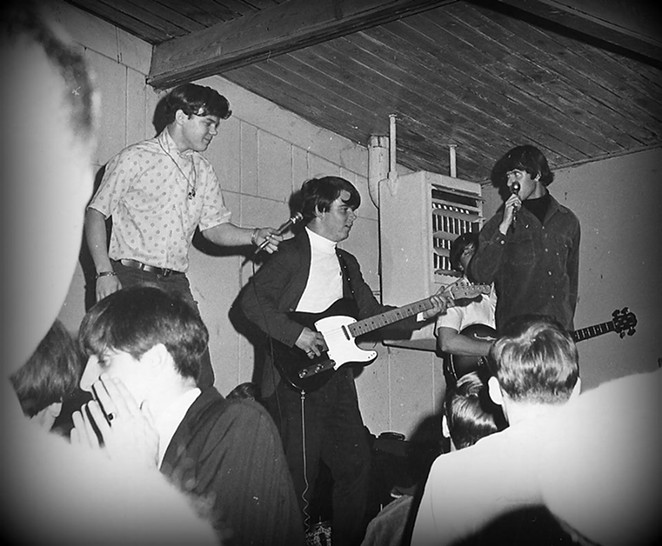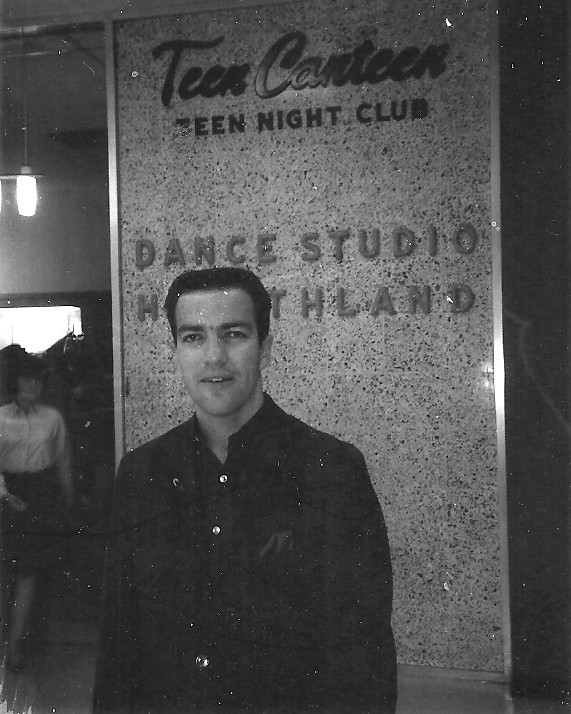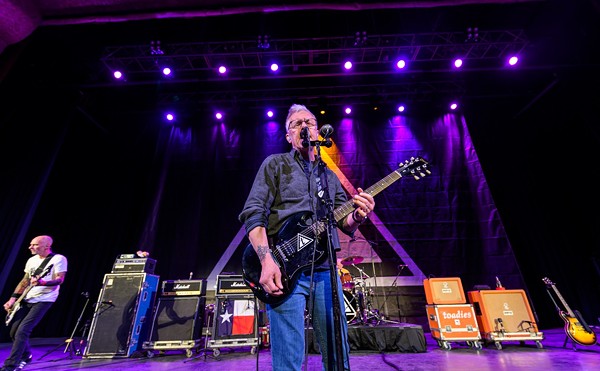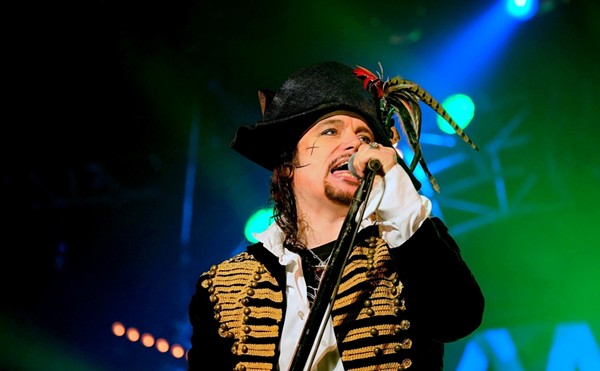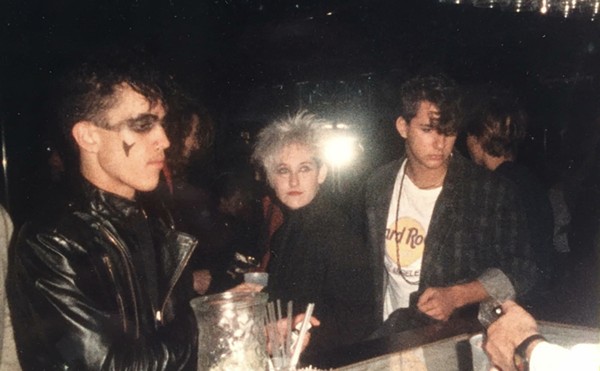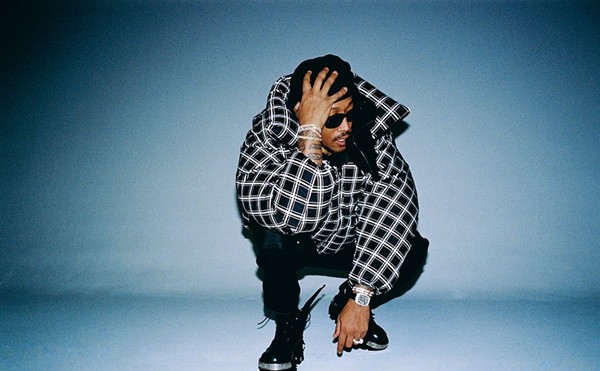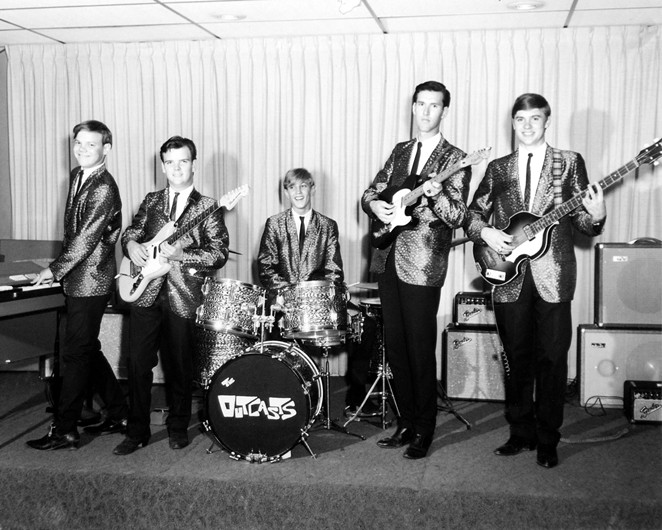
Short-lived bands including the Outcasts, the Stoics, the Chayns, the Five Canadians, Sweet Smoke, the Laughing Kind, the Argyles and the Pandas issued a string of a propulsive, proto-punk singles that are both wildly unhinged and wonderfully addictive. To be sure, when record collectors voted on the 1,000 top U.S. garage 45s for Mike Markesich’s book TeenBeat Mayhem!, San Antonio had five records in the top 30.
“The best garage-rock records from the city have the same qualities ... a willingness to experiment and cut loose, and a commitment to intense performances,” said Chris Bishop, who operates garagehangover.com, a massive online resource on the ’60s garage rock phenomenon. “For that short heyday of the garage sound, San Antonio deserves to be as legendary as any Texas city. San Antonio’s music scene was more diverse, though, with many Hispanic artists, which may have made it harder to categorize.”
Texas garage and psychedelic rock have long been prized among record collectors, and they continue to be a source of inspiration for a new generation of musicians. In recent years, the rock underground has percolated with acts exploring both garage and psych sounds. Its influence is apparent on bands as diverse as Thee Oh Sees, Tame Impala and Kikagaku Moyo, and it’s the central draw of Austin’s massive Levitation festival.
“The word ‘intensity’ is synonymous with Texas music. And Texas has a reputation of being wild. Those two things together play a big part of Texas psych,” said Marc Smith, the mastermind behind current day psych-blues act Mockingbird Express, which operates out of the Alamo City. “San Antonio is unique in Texas, because it’s always been a crossroads city. And, as we know from Robert Johnson, crossroads are necessary for great music.”
Indeed, that crossroads aspect of San Antonio proved crucial to its mid-’60s music scene. Our numerous military bases not only imported new people and ideas from around the country; they provided a crucial source of gigs for developing bands.
“It was an interesting situation because, well, there were actually places to play,” recalled Jim Ryan, bassist for legendary SA garage rockers the Outcasts. “All the air bases around town had clubs — enlisted men’s club, officer’s club, teen club. Fort Sam had at least four places to play. We’d be booked three, four, sometimes five nights a week at these military clubs.”
That demand for live entertainment created a thriving atmosphere, with separate music scenes popping up across town.
Teen Fair
The West Side Sound, which blended R&B and Latin influences, for example, was largely captured by Abie Epstein and his studio at 735 North General McMullen Dr. Epstein cut more than 900 45 rpm singles, many of which were recently reissued by Chicago’s influential Numero Group label. While he’s best remembered for his West Side soul releases, the studio owner also had an impact on the city’s garage scene, recording many of its best singles, including releases by the Mind’s Eye, the Argyles, and Robb London and the Rogues.
Epstein was a force of nature on the city’s Hispanic West Side, but the focus of the garage rock scene lay primarily on the city’s largely Anglo Northern stretch. The undisputed impresario of that music scene was the visionary Sam Kinsey and his Teen Canteen. As a record shop owner, Kinsey had his ear to the ground. Although a few years older than his patrons, he was among the first people locally to recognize to recognize an explosion of youth culture and organize events around it.
Among Kinsey’s noteworthy shindigs was the 1964 Teen Fair of Texas, which gave the Rolling Stones one of their first U.S. shows. It was a disastrous affair. The opening act was a group of trained monkeys — yes, really — and the crowd in the largely empty Joe and Harry Freeman Coliseum booed the band offstage. Afterwards, a group of cowboys taunted guitarist Brian Jones for his long hair. Undaunted by the jeers, Jones walked up and crushed one of the rowdies’ Stetsons over his eyes.
The Rolling Stones never forgot the gig. When they returned to San Antonio in 1974, Mick Jagger told Kinsey, whom he’d personally invited to the concert, “I wanted you to see we could draw a crowd.”
That first Stones show might have been a disaster, but it inspired the bevvy of up-and-coming garage rockers who were in attendance. The Outcasts’ lead singer, Buddy Carson, was particularly taken with Jagger’s strutting, which he incorporated into his band’s live performances at after Kinsey opened his own venue, the Teen Canteen. The spot’s modular stage allowed bands to assemble the pieces in ways that catered to their own stage shows.
“The Outcasts definitely designed the best stages,” remembered Bob Galindo, who performed in the Laughing Kind, the Zilches and the Bourbons, and whose brother Dan Galindo played bass for legendary Austin psych rockers the 13th Floor Elevators. “It had a small runway for Buddy Carson to do his Mick Jagger impersonations, which were excellent.”
The Teen Canteen hosted innumerable shows for both new and established bands, quickly becoming a hot ticket for Alamo City residents hungry for rock ’n’ roll. Hundreds of teens regularly packed the performances, dancing for hours.
“Imagine that! A place for young bands to play,” marveled Galindo in a program created for a 2010 Teen Canteen reunion.
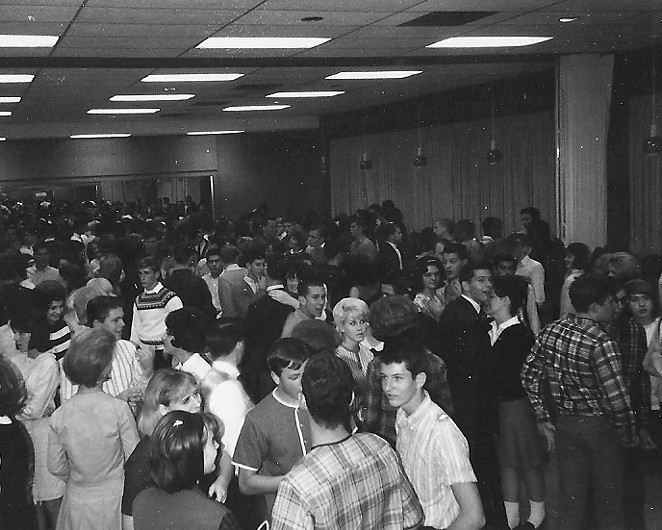
The venue began at Jefferson Methodist Church Hall, then subsequently moved to Wonderland Mall, its most famous location, where it resided until 1968. After a bit more shuffling, it relocated across from Northeast Stadium, where it lasted until 1977.
Kinsey envisioned the Teen Canteen as a safe, wholesome place for kids to enjoy music and create their own culture. It was also a place where parents felt safe leaving their teenagers. The space had a dress code and strict no-alcohol policy, and in its earliest days, drugs hadn’t yet entered the picture.
“Sam Kinsey was different than most people. He had rules and decorum. Morality standards quite different than bars,” said Hector Saldana, frontman of ’70s garage rock revivalists the Krayolas and Texas music curator for the Wittliff Collections at Texas State University, where Kinsey’s archives are held. “Kinsey gave these young people an outlet. It was an incubator.”
To be sure, the Teen Canteen emerged as a crucial proving ground for prime regional talent. The venue gave ZZ Top its first paying gig — $150 on September 13, 1969 — and booked Billy Gibbons’ pre-ZZ garage band the Moving Sidewalks. It also played host to a pre-Monkees Mike Nesmith and SA’s legendary Sir Douglas Quintet, whom Bob Dylan once described as his favorite band. Augie Meyers’ Lord August and the Visions of Lite played the Canteen’s grand re-opening at Wonderland in 1968.
Another of the Canteen’s early acts was Christopher Cross’ Flash. Cross later went on to stratospheric multi-platinum success as a ’70s and early ’80s soft rocker. But early on, with Flash, the Alamo Heights High School grad was known as a local guitar hero.
In Kinsey’s eyes, a healthy rock music scene actually was of great benefit to the community at large.
“My main purpose of pursuing that business was to generate an income,” Kinsey said in a phone interview. “Later, I found it supported the local musicians. Finally, I found an unintended effect of the place was the positive effect it had on the attendees’ lives. It kept some people from dropping out of school because if they dropped out of school ... they could not attend the Teen Canteen.”

But it wasn’t just famous names that made up the fabric of San Antonio’s garage scene. The thriving environment birthed dozens of lesser-known bands that pushed and inspired each other. Along the way, they also attracted legions of adoring female fans.
“That was the way to meet girls ... woo women,” said Ryan, bassist for the Outcasts. “It was fairly competitive, but we were all friends. If somebody won the battle of the bands, that was fine, we just went on to different places, different dates and different groups. It was a fairly thriving scene.”
The Outcasts’ two singles, “I’m in Pittsburgh” and “1523 Blair,” are now among the most prized garage rock 45s of the era.
“Last I checked, they were going for about $800 on eBay,” laughs Ryan.
The band’s career began with gigs on military bases and slots on battles of the bands, culminating in a stint as Teen Canteen’s house band for more than a year. After opening for British invasion group Herman’s Hermits, the Outcasts hooked up with the two most influential music producers in Texas — the infamous Huey Meaux, who produced the Sir Douglas Quintet, the Big Bopper and innumerable No. 1 hits, and Leland Rogers, brother of country star Kenny Rogers and impresario of Houston’s International Artists, perhaps the most legendary psych label of the ’60s. The Outcast’s singles charted locally but stalled out around No. 30.
“We didn’t have the payola to make it go,” Ryan said with a laugh.
During those boom days, studios popped up to document the SA sound, as did new clubs and psychedelic shops. Besides Epstein’s aforementioned studio on McMullen, Jeff Smith’s Texas Sound Studios and Jim Ridgeway’s Alamo Audio helped document the burgeoning scene. Alamo Audio also ran a label of the same name that custom pressed record in editions of 100 to 500 copies, perfect for local distribution.
The emerging clubs included the Mind’s Eye on Austin Highway, the Love Street Light Circus on Commerce Street, the Mystic Moor on Austin Highway, Home on San Pedro and the notoriously hip Pusi-Kat Club near La Villita. A Southside alternative to Kinsey’s venue, Teen Town, popped up in McCreless Plaza. Later, head shops and psych stores included the not-so-subtly-named Joint Effort and Granny’s Teahouse also made an appearance.
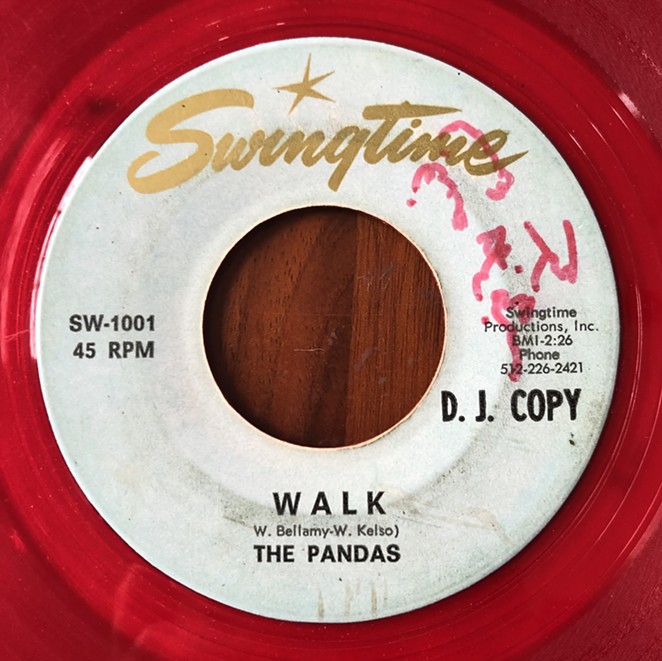
Also contributing to the explosion was a radio landscape vastly different from today’s.
Singles by San Antonio garage acts actually got play on major radio stations alongside records by nationally known artists. Long before Clear Channel and I Heart Media imposed playlist monotony, local DJs had autonomy and were able to take chances on local and regional bands.
Homer, a San Antonio garage group that rose from the ashes of the Outcasts, landed on the local charts by giving local DJs copious amounts of prime beef as enticement for spinning their records — God bless Texas. Homer guitarist Galen Niles’ father, a supermarket manager, made the arrangements. Niles sprung from the garage scene to become the city’s reigning guitar hero for years, first with the Outcasts, the Pandas and Homer, then forming Ultra, which played arguably the most famous gig in local history — the Sex Pistols’ legendary performance at Randy’s Rodeo.
After 1967 brought the Summer of Love to San Francisco, a similar vibe began to permeate the Alamo City’s music scene. Garage rock morphed into psych.
Among the bands who underwent that evolution were the Stoics, a mixed-race band whose one single “Hate” is now considered a garage-rock classic. After splintering, members formed another group, The Argyles, who, after releasing some excellent singles, morphed yet again into The Mind’s Eye. The latter group’s single “Help, I’m Lost” — a multi-layered affair featuring a violin plus a raga-esque guitar solo from Galen Niles — remains of one of the great, um, lost singles of San Antonio music.
To accommodate the mind-expanding scene sprouting up around them, the Mind’s Eye even opened a club of the same name on Austin Highway, adjacent to the old Seven Oaks. It’s now a parking lot. Band lead guitarist Steve Perron managed the venue while Charles Winans — the Sir Douglas Quintet’s first manager and arguably the city’s biggest “head” at the time — ran the lightshow. Old Heckle and Jeckle cartoons flickered on its inside walls.
“Really good vibe in that place. Very psychedelic,” Ryan of the Outcasts recalled. “We played there many times. It wasn’t around that long unfortunately.”
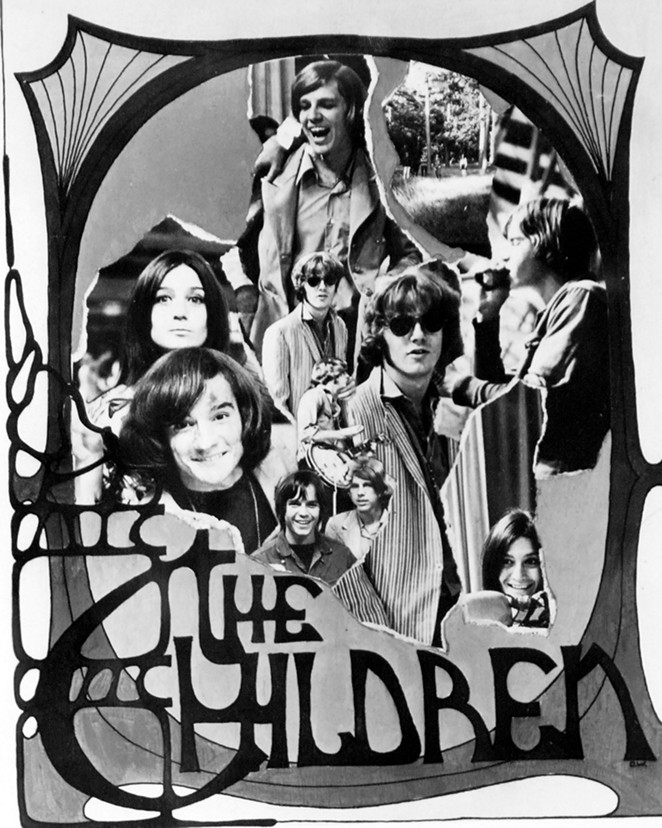
The club’s overtly drug-influenced name made it a target for local law enforcement. After only a few months, the Mind’s Eye shuttered the venue and moved to LA, where Monkees frontman Davy Jones agreed to produce their debut record. He even repped the group on the famed Sunset Strip.
Amid money and drug problems, though, the group retreated to San Antonio, sans album, but with a new name: The Children. The Children’s one album, Rebirth — recorded with International Artists’ Rogers at the controls — is now considered a classic of Texas psych. Even if it went nowhere at the time. A second album, to be helmed by Lou Adler, the renowned producer behind Carole King’s Tapestry and other smashes, fizzled out amid more drug drags and money squabbles.
Just as groups disbanded, reformed, morphed and fizzled, San Antonio’s scene itself was ever changing, and by 1968, it had started to dissipate. Looking to for wider fame, some SA bands preferred to go to Houston to record, while others, most notably Bubble Puppy, found success in Austin.
By 1973, Texas also lowered its drinking age to 18, forcing the teen club scene to compete against regular bars. The Teen Canteen shortened its name to the Canteen. While it continued to provide a crucial proving ground for local talent, the initial magic had largely faded.
“The marijuana scene came along, and I had to learn the scent, as the doorman,” Teen Canteen’s Kinsey recalled with a laugh. “Somebody would walk in and I’d say, ‘Oh, I like your cologne.’ They’d say, ‘Oh, I’m not wearing cologne.’ Then I’d sniff. ‘Oh, I swear I smelt some new cologne on you.’ And that was the cool way to let them know that I knew.”
As harder drugs filtered through the scene, the innocence filtered out. Momentum stalled. The garage rock scene, almost as soon as it appeared, vanished. Not surprising, though. That ephemeral quality is intrinsic to youth culture. Kids grow up and scenes dissolve for numerous reasons — college, the draft and addiction all played their part in this case.
“That’s the culture of rock ’n’ roll. You get one shot,” said Ryan of the Outcasts.
Digging Up Nuggets
The glorious rush of garage rock had passed. But it was ripe for rediscovery.
As primitive early rock ’n’ roll gave way to the pomp and virtuosity of ’70s prog, something got lost. Namely, the fun. Early punks sifted through the remnants of the ’60s looking for inspiration. Most notably, future Patti Smith Group guitarist Lenny Kaye assembled Nuggets, a two-LP compilation celebrating overlooked rock 45s. It was the book of Genesis for the nascent punk movement, and its liner notes even contained the first written reference to “punk rock.”
Eventually, Nuggets became a series of releases, then a box set, and other comps surfaced, digging up obscure singles from the era.
“We got labelled punk in the ’70s, and it seemed to fit the bill,” the Outcasts’ Ryan said.
By that point, rock culture was already mining its own past, finding inspiration in an earlier incarnation, whose unbridled energy now felt missing from the scene. The old became the new.
“Nuggets did what I always hoped it would do: spark this kind of archaeological interest, so all of a sudden, people started digging around for group garage band records. ... So, it just kind of continues on and on and on,” Kaye told the website MusicScribe in 2019.
That kind of rediscovery is ongoing, and it’s continued to shine a light on San Antonio’s rich garage rock scene. Taken as a whole, the city’s output from the period is as good as anything on Nuggets, if not better. Alamo City garage 45s are some of the most highly prized — and highly priced — records on the collector market. The culture spawned by Nuggets has singled out San Antonio as singularly important, and numerous singles of the era popped up on subsequent compilations.
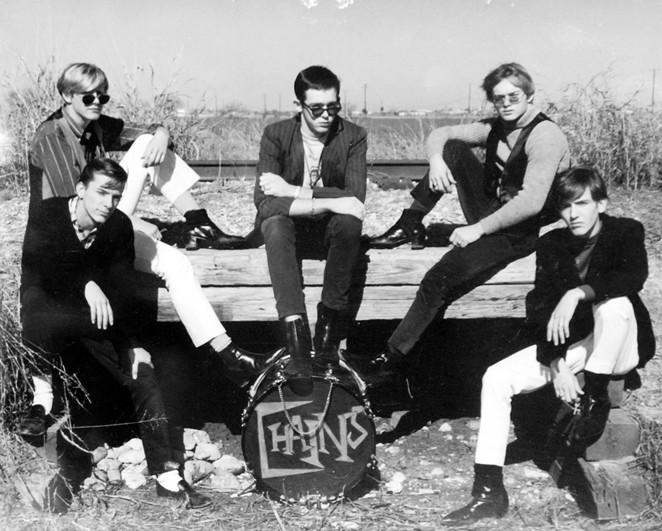
One of these comps, Highs in the Mid-Sixties, was Mockingbird Express frontman Smith’s first exposure to San Antonio’s first-wave garage and psych. Five volumes of that 23-record series were dedicated to Texas music alone.
“The sheer number of amazing Texas bands would surprise a lot of people,” Smith said.
In 2021, San Antonio is still a crossroads city, and the vibrant feel of its early garage days continues to resonate.
“A lot of south Texas musicians feel a personal and spiritual connection with where it all came from,” Smith added. “There is an intensity, not just in how musicians play, but with how we consume music as well. There is a hunger here for rock ’n’ roll, particularly. It’s in the soil, the air, the water and in people’s blood around here.”
In 2017, San Antonio’s Psych Del Rio fest brought together the city’s garage-psych history with its new generation carrying the torch. The 1960s garage legends Bubble Puppy shared the bill with a bevy of San Antonio newcomers, including True Indigo, fronted by Oscar Webber. (As an aside, Jason Chronis, who supplied images of some of the records running with this story also played Psych Del Rio with his group Tele Novella.)
“Music from the ’60s, I get a lot of inspiration from that,” Webber said of his band’s debt to the forbears of the Alamo City’s mind-expanding sounds.
The original wave of San Antonio garage rock, though short-lived, created compelling music that’s now being rediscovered by another generation of local musicians tired of antiseptic, sanitized, auto-tuned pop. Even if those old records might be a little out of tune, that’s precisely the point. The songs brim with pure, unfiltered energy.
The recordings are still out there, breadcrumbs for those interested in learning the history of their own city and one of the truly great eras of rock ’n’ roll.
“They have this reckless abandon,” reflected Saldana, the Wittliff curator. “It’s almost like pure expression.
There’s no denying the creativity and the energy of these records.”
19 Essentials of SA Garage Rock, 1965-68
The Runaways — 18th Floor Girl
The Chayns — There’s Something Wrong in This
Place
Five Canadians — Writing on the Wall
The Outcasts — I’m in Pittsburgh (and it’s Raining)
The Stoics — Hate
The Pandas — Walk
The Mind’s Eye — Help, I’m Lost
Lord August and the Visions of Lite — Let Me Be Me
The Chayns — Night Time
The Bourbons — Of Old Approximately
Sweet Smoke — Mary Jane is to Love
Botumles Pit — 13 Stories High
The Laughing Kind — I Could Have Showed You the Way
The Barons — Come to Me
The Argyles — Still in Love with you Baby
Robb London and The Rogues — Bitter Tears
Cyrkle Of Sound — Lies
Homer — Dandelion Wine
The Children — Pictorial
For more San Antonio garage classics, tune into this Mixcloud playlist at mixcloud.com/sasound/sa-garage-1965-1968.
Stay on top of San Antonio news and views. Sign up for our Weekly Headlines Newsletter.

